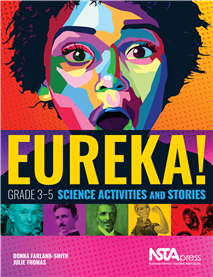Eureka! Grade 3-5 Science Activities and Stories
By Carole Hayward
Posted on 2018-01-08
Elementary teachers have to balance the challenges of literacy instruction with high stakes testing and content area instruction. What teachers need to achieve this delicate balance is a text that can be both an instructional tool and a step-by-step guide for building thought-provoking lessons. Enter Eureka! Grade 3-5 Science Activities and Stories by Donna Farland-Smith and Julie Thomas.
What makes this book unique is the focus on the lives and discoveries of famous scientists and inventors. The book includes 27 lessons and recommends children’s trade book biographies to accompany each lesson. Biography subjects include astronomer Galileo Galilei, primatologist Jane Goodall, astronomer Annie Jump Cannon, and engineer William Kamkwamba. Also, each chapter has literature-based lessons that support the Next Generation Science Standards (NGSS).
“Our bold new idea is that biographies of scientists can allow you to highlight the human dimension of scientists and engineers while you encourage science learning. We think these stories will broaden students’ perceptions of scientists and engineers as real people and add explicit and implicit opportunities for them to consider science and engineering careers,” Farland-Smith and Thomas state in the introductory chapter.
An interesting dimension of the book is the focus on character traits. “Each featured scientist and engineer is introduced with a character trait. These capture the unique human qualities of the scientists and introduce the human assets of scientists’ dispositions. It is important to mention that every individual has such traits, and the focus here is on helping students understand that scientists and engineers are people and express personal, human traits that enable them to be successful,” the authors state.
The book helps to make science more real and relatable. Students can explore the character traits, processes, practices, successes and failures of scientists who have helped to change our society and improve our lives, and imagine themselves making important discoveries of their own.
For example, in the second chapter, which focuses on the trait of “thinker,” students will learn about Philo Farnsworth, who invented television. Using their thinking and tinkering skills, students will develop their own inventions or create a replica of an invention from recyclables or everyday materials. With this lesson, teachers can spark a conversation about how inventions can have a great impact on a society during a particular time in history.
Students will practice asking questions, troubleshooting, and working through the steps of the design process to create something that just about every child loves: a TV. In addition, the lesson connects to the NGSS by asking students to define and delimit engineering problems, as they learn how to eliminate materials and unsuccessful designs in the creation of their invention. They will also get to practice communicating with their peers about proposed solutions and their design process.
To learn more about Eureka! Grades 3-5 Science Activities and Stories, read the sample chapter here.
This book is also available as an e-book.
Follow NSTA
Disclaimer: The views expressed in this blog post are those of the author(s) and do not necessarily reflect the official position of the National Science Teaching Association (NSTA).


